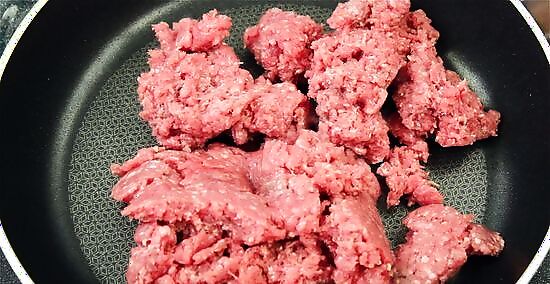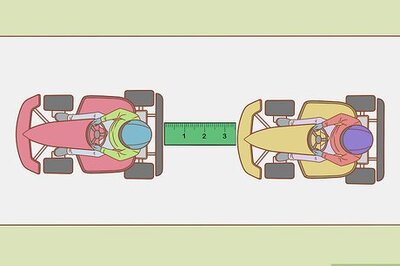
views
Using the Stove

Thaw the beef in the refrigerator for a day if it is frozen. Fresh ground beef doesn’t need to be thawed, but frozen ground beef should be moved to the refrigerator before you need to cook it. Keep it wrapped in its original packaging. The cool temperature protects it from bacteria as it unfreezes, so you can keep the ground beef in there for up to 2 days after defrosting. If you need to thaw larger packages of beef, give them additional time in the refrigerator. For example, a 2 lb (0.91 kg) package of beef needs to be in the refrigerator for 2 days. If you are in a hurry, move the beef to the microwave. Use a defrost setting or set your microwave to 50% power. Gradually heat the meat until it is no longer icy but still cold. Another way to defrost is with cold water in your sink. Keep your beef in its plastic wrapping or move it to a watertight container. Submerge the beef, changing out the water every 30 minutes. Keep doing this until the beef is cool but not icy.

Spray a frying pan with nonstick cooking spray. The spray prevents the ground beef from sticking to itself and the sides of the pan. It makes cooking a lot easier. If you have a nonstick pan, spraying the pan isn’t necessary, but it can still be helpful. Make sure you fully coat a frying pan big enough to hold all of the meat you wish to cook. Your pan needs to provide plenty of space so you can move the beef around. If you are cooking more than 1 lb (0.45 kg) at a time, you may need to cook the beef in batches. Instead of cooking spray, you can add up to 2 tsp (9.9 mL) of a cooking oil to the pan. This is useful for lean beef or nonstick pans.

Heat the pan over medium-high heat. Get your pan nice and hot before adding the beef! You can test this by adding a few drops of water to the pan. When the pan is hot enough, the water will evaporate immediately. That means your pan is ready for the beef. A cold pan won’t cook the beef properly. The beef will begin losing juices without browning and turn gray. Remember that adding cold beef lowers the pan’s temperature, so heat the pan well before cooking.

Put the beef in the pan and let it brown for 3 minutes. Drop the beef into the pan without breaking it up. A good strategy to keep in mind is to move the beef as infrequently as possible. Let it cook for at least 2 or 3 minutes so it turns a nice, even brown on 1 side. When you notice the edges crisping, you know the beef is ready to be flipped. Infrequent stirring ensures that all sides of the beef get a chance to brown evenly. Ground beef cooks very quickly, so don’t walk away from your stove. Avoid adding water to the pan unless you want gray, steamed beef. If you wish to use water, add ⁄4 c (59 mL) for every 1 lb (0.45 kg) of beef you cook.

Flip the beef over and break it into small chunks with a spoon. The beef will break apart a little when you flip it, but continue to divide larger pieces by pressing the edge of your spoon or spatula down onto them. Make sure all of the beef is flipped over onto its pink side, then let it cook for another 2 or 3 minutes. Ground beef breaks apart easily, so stirring it in the pan isn’t much of a challenge despite the short cooking time. Now is a good time to sprinkle the beef with a generous amount of salt to draw out additional flavor.

Turn the meat often until all red and pink parts turn brown. Stir the beef in the pan using your wooden spoon or spatula, continuing to break up large pieces. Find any uncooked surfaces and keep them down against the pan. Cook the beef for a minute or 2 before stirring and checking again. Ensure the meat is fully cooked by checking the temperature with a thermometer. All pieces should be at least 160 °F (71 °C). Ground beef takes approximately 7 to 10 minutes to cook all the way through, although this varies depending on your stove. Turning the beef often ensures that 1 section doesn’t stay directly on the pan for too long and burn.

Pour the beef into a colander to drain the fat and juices. Hold the colander over a trash bag, if possible, or set it on top of another pot. You can spoon the beef into the colander with a slotted spoon to avoid picking up most of the juice in the pan. Dump the fat into the trash once it cools. Another way to do this is to set out some paper towels on a plate. Lay the beef on the paper towels, then use another paper towel to dab the beef dry. Try not to pour grease down the sink, since it can lead to clogs.
Cooking in a Microwave

Defrost the beef for a day in the refrigerator if it is frozen. When using a microwave, you have to pack the beef into a microwaveable container. Frozen beef is too solid for you to do this effectively. Thaw the beef first by moving it to the refrigerator a day before you need to cook it. You can also use the defrost or 50% power on your setting to heat the beef until it is no longer icy. Defrosting in cold water also can work. Make sure your beef is in a watertight container. Submerge the container in the water, draining and replacing the water every 30 minutes until the beef is no longer frozen.

Choose a microwave-safe container or plate. Cook ground beef only in a container or plate that can withstand the intense heat. Glass or ceramic, such as a casserole dish, usually work well. Get a shallow, circular container if you can, since the shape helps the beef cook more evenly. Choose a dish large enough to hold all of the beef or microwave it in separate batches if necessary. A metal steamer basket or colander can be effective for microwaving ground beef. You can also place the beef in a bowl set in the basket or colander to automatically drain fat. Some plastic containers release harmful chemicals when heated. Check plastic containers to see if they have the words “microwave-safe” printed on them. Avoid using a container if you aren’t sure it is safe.

Arrange the beef so it is as flat on your plate or container. Place your plate or container in the microwave. Take the beef out of its packaging, then spread it out across the plate. You shouldn’t have any trouble pressing the beef down by hand or with a spoon. Break the beef into smaller chunks as needed to distribute it evenly across your container. If the beef is hard to break apart, defrost it in the microwave at a low temperature for about 2 minutes, then try again. You can add 1 cup (240 mL) of lukewarm water to the container to speed up the cooking time. This will cause your beef to turn more gray than brown since it will cook through steaming.

Cover the container with a microwave-safe lid. Make sure the lid is designed for heat exposure. Glass, ceramic, and safe plastic lids are all acceptable, especially if they match the container. Microwave-safe lids won't retain enough steam during the short cooking time, so you don't have to worry about your microwave turning into modern beef art. If you don’t have a matching lid, cover the container with a tight layer of plastic wrap. Cut some vents into the wrap so steam escapes.

Cook the beef on medium heat for 5 minutes. Choose a number 5 or 50% power setting on your microwave. Such a low heat setting cannot cook the beef all the way through, but it can cause the beef to warm more evenly. High temperatures tend to leave the edges of the beef piping hot and the center stone cold, similar to that frozen pizza pocket you may have tried heating once. You can adjust the settings if you wish. Microwaving on a high heat setting is fine, but be cautious. Make sure the beef reaches a safe temperature before you use it. Consider cooking the beef for shorter bursts as well, such as 2 minutes at a time. This will ensure that the temperature stays consistent across the beef.

Break the beef apart and stir it in the container. Use a wooden spoon or another tool to divide up the ground beef as much as possible. Rearrange it in the container so the colder, pinker parts are on the outside and the warmer, browner parts are in the center. Flatten the beef out as much as possible before putting the lid back on. Stirring the beef is an important part of getting an even brown coloring since microwaves cannot heat all of it consistently.

Cook and stir the beef again as necessary until it is brown. Cook the beef for 2 to 5 minutes, take it out of the microwave, and stir it to bring any pink parts to the outside of the container. You may need to do this a few times before the beef is cooked all the way through. When it is finished, it should be completely brown and have an internal temperature of 160 °F (71 °C), which you can check with a thermometer. Expect the cooking process to take between 7 to 10 minutes, not counting the time spent stopping and stirring. This will depend on the heat settings you use.

Drain the beef in a colander. Set out a colander and dump the beef into it to eliminate the fat. Ideally, you should avoid letting the fat drain down the sink, but this can be tough to do with a colander. You can try holding the colander over a pot, jar, or another container, then dumping the beef into it. You can also set the cooked beef on paper towels. Pat it down to speed up the drying process. Wait for the fat to cool before putting it in the trash.




















Comments
0 comment